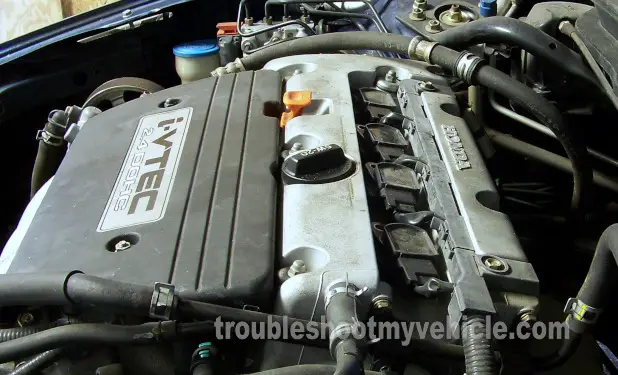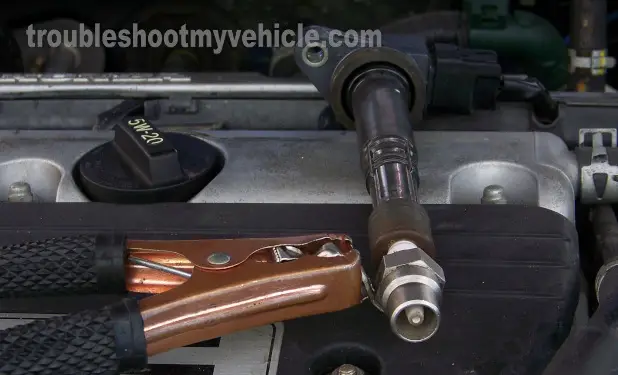
As you may already know, your Honda with a 2.4L 4 cylinder has four individual ignition coils. These ignition coils are commonly known as Coil On Plug (COP) ignition coils.
What you may not know is that testing them is pretty easy. Furthermore, you don't need any expensive diagnostic equipment. In this tutorial, I'll show you how to do it in a detailed step-by-step fashion. You'll be able to say that “Yes, the COP coil is bad” or “No, the COP coil is NOT bad”.
Contents of this tutorial:
![]() You can find this tutorial in Spanish here: Cómo Probar Las Bobinas De Encendido (2003-2006 2.4L Honda Accord) (at: autotecnico-online.com).
You can find this tutorial in Spanish here: Cómo Probar Las Bobinas De Encendido (2003-2006 2.4L Honda Accord) (at: autotecnico-online.com).
APPLIES TO: This tutorial applies to the following vehicles:
- 2.4L Honda Accord: 2003, 2004, 2005, 2006.
- 2.4L Honda Element: 2003, 2004, 2005, 2006.
WIRING DIAGRAM: The following ignition coil wiring diagram complements this tutorial:
IGNITION SYSTEM TESTS:
- How To Test The Crankshaft Position Sensor (2003-2007 2.4L Honda Accord).
- How To Test The Camshaft Position Sensor B (2003-2007 2.4L Honda Accord).
Symptoms Of A Bad COP Ignition Coil
When one or more COP ignition coil fails, the engine in your Honda will experience a misfire condition. This translates into an engine that's not running on all cylinders.
The most obvious symptom of bad cop ignition coil, is a miss at idle and when you accelerate your Honda down the road.
You're also gonna' see the check engine light (CEL) shining nice and bright on your instrument cluster and one (or several) of the following:
- Diagnostic trouble codes:
- P0300: Random Cylinder Misfire.
- P0301: Cylinder #1 Misfire.
- P0302: Cylinder #2 Misfire.
- P0303: Cylinder #3 Misfire.
- P0304: Cylinder #4 Misfire.
- Rough idle.
- Smell of raw gasoline coming out of the tailpipe.
- Bad gas mileage.
- Won't pass the emissions test.
- Extended cranking time (hard start).
- If more than one ignition coil is bad, your Honda won't start.
If your vehicle is experiencing any of the above symptoms, chances are that you do have a bad COP coil on your hands. Let's take a look at some of the basic tools you'll need to diagnose and repair this yourself.
CYLINDER MISFIRE DIAGNOSTICS: A comprehensive guide to diagnosing a cylinder misfire and misfire diagnostic trouble codes:
What Tools Do I Need To Test The COP Coils
The most important tool that you're gonna' need, to test the ignition coils for spark, is a spark tester.
A lot of folks check the COP ignition coils for spark by simply pulling the ignition coil off of the spark plug (while the car is running)and hearing for the audible clicking sound the spark makes. But, this is the worst way to check for spark. Why? Because you run the risk of damaging the ignition coil you're testing in this way.
I'm gonna' recommend one that is the most effective (and the most inexpensive) out there: the HEI spark tester (OTC 6589 Electronic Ignition Spark Tester).
From personal experience (I work full-time as an automotive tech) I can tell you that the HEI spark tester is a must-have tool. You don't need to interpret the color of the spark or the weakness of it. If the HEI spark tester sparks then you can conclude that the ignition coil is good.
- An HEI spark tester.
- To find out more about this inexpensive yet accurate spark tester, go here: The HEI Spark Tester (The Best Spark Tester On The Market) (this article at: easyautodiagnostics.com).
- If you need to buy one, you can buy it here: OTC 6589 Electronic Ignition Spark Tester
- Scan tool.
- A scan tool is not needed to check the COP coils with the info I'm presenting in this tutorial but it does come in handy to retrieve the misfire DTC (diagnostic trouble code).
- Don't have one? Check out my recommendation: Actron CP9580 Scan Tool Review.
- Wire piercing probe.
- Although this tool is not an absolute must, if you do buy one, you'll realize just how easy it makes testing the voltages inside the wires.
- If you need to see what this tool looks like, you can see it here: Wire Piercing Probe.
How Does The COP Coil Work?
Although it's not absolutely necessary to know how the ignition coils work on your Honda vehicle, I've included a brief description of how they work (for those of you who love to read the how and why of stuff).
In a nutshell, the COP ignition coil's job is to create and deliver spark to the spark plug.
Having an individual ignition coil per cylinder allows for a more maintenance free ignition system, since you have less moving parts that may wear out and that eventually need to be replaced, like:
- A mechanical distributor assembly.
- Distributor cap.
- Distributor rotor.
- Spark plug wires.
Now in case you're really curious about how it works, below is a very brief description of the whole process:
- When you turn the key and crank the engine, power and Ground are supplied to 2 of the 3 wires sticking out of the COP ignition coil's electrical connector.
- The PCM (Powertrain Control Module = Fuel Injection Computer) gets the crankshaft position signal from the crank sensor.
- The PCM now activates each COP ignition coil.
- This activation signal (Triggering signal) is supplied to the third remaining wire of the COP ignition coil's electrical connector.
- This Triggering signal activates an ignition module (also known as the power transistor) within the ignition coil
- The ignition module, in turn, starts to switch the ignition coil 12 Volts ON and OFF (by interrupting the coil's Ground circuit). Remember, all this is happening inside the ignition coil.
- It's the switching ON and OFF of the primary current (the fancy name for 12 Volts) that causes the COP coil to spark.
- With all 3 signals supplied (power, ground, and the triggering signal), the ignition coil now starts to spark.
- With fuel being injected, the engine in your Honda comes to life.
OK, with this brief overview of how the COP ignition coil works on your 2.4L equipped Honda, let's get testing.
TEST 1: Checking For Misfire Codes

The very first thing you need to do, check for misfire codes. More likely than not, if your Honda is experiencing a bonafide misfire condition, the check engine light (CEL) is shining nice and bright on your instrument cluster and this means that there's a diagnostic trouble code (DTC) stored in the computer's memory.
Why check for diagnostic trouble codes first? Because the misfire code will help you in identifying which cylinder is the one that could have a bad ignition coil and knowing which ignition coil to test is half the misfire diagnostic battle.
Now, if you don't have a scan tool, you can still use the info in this tutorial but you'll need to do a cylinder balance test. For more info on this, go to: TEST 4: How To Do A Cylinder Balance Test.
Let's get started:
- 1
Connect your scan tool or code reader to the diagnostic link connector (DLC).
- 2
Turn the key to the ON position.
- 3
Read the diagnostic trouble codes stored in the computer's memory.
Choose from one of the cases below:
CASE 1: You have a misfire code. The next step is to find out if this misfire code is being caused by a bad COP ignition coil. Go to: TEST 2: Check The Ignition Coil For Spark.
CASE 2: You have a P0300 misfire code. This means that whatever is causing the misfire condition, is affecting all of the engine cylinders and not just one.
This code, the (P0300) usually rules out a bad COP ignition coil and/or a fuel injector as the culprit. Although it's beyond the scope of this article, I do have a few suggestions for you and these are to:
- Check to see if one or more engine cylinders have low engine compression.
- Check for vacuum leaks.
CASE 3: You DO NOT have any misfire codes. This usually means that the rough idle that your Honda is experiencing is not being caused by a bad COP coil.
Now, the keyword here is ‘usually’ because your Honda could have a bad COP coil. What I suggest you do, is to do a cylinder balance test (TEST 4: How To Do A Cylinder Balance Test).
Also, and preferably after you do the cylinder balance test, you need to do a thorough visual inspection of the spark plugs, COP coils to see if:
- Spark plugs are not:
- Soaked in engine oil (leaking valve cover gasket).
- Soaked in water (from power washing the engine).
- Cracked or broken.
- Center electrode's gap is filled/covered with carbon (from the cylinder burning oil).
- COP coils are not:
- Soaked in engine oil (leaking valve cover gasket).
- Soaked in water (from power washing the engine).
- Cracked or broken.
If all of the above checks out, I would suggest an engine compression test.
TEST 2: Check The Ignition Coil For Spark

After having identified the misfiring cylinder (either through a diagnostic trouble code check or a cylinder balance test), the next step is to check to see if the COP ignition coil is sparking or not with a spark tester.
My instructions below call for an HEI spark tester and if you don't have one, you may be wondering if you can use any other type of spark tester.
And the answer is: ‘Yes, you can use any type of spark tester you want or have’. The only reason I use and recommend the HEI spark tester is because this spark tester is accurate (and you don't have to worry about interpreting the color of the spark).
OK, to get this pie baked, this is what you need to do:
- 1
Remove the ignition coil from its place on the valve cover.
- 2
Connect an HEI spark tester to the ignition coil.
- 3
Ground the HEI spark tester with a battery jump start cable directly on the battery negative (-) terminal.
- 4
When everything is set up, have a helper crank the engine while you observe the spark tester.
- 5
The spark tester will do one of two things: Spark or not spark.
Let's see what your test results mean:
CASE 1: The COP ignition coil sparked. This is the correct and expected test result and tells you that the ignition coil is OK.
Now, since that cylinder is the one that the trouble code is accusing of as being 'dead', you now need to look to see if and/or perform the following tests:
- Check to see if engine oil is dripping onto the spark plug and COP coil boot from the valve cover gasket.
- Check to see if the spark plugs have carbon tracks on their porcelain insulator.
- Do an engine compression test to see if that cylinder has low engine compression.
CASE 2: The ignition coil DID NOT spark. This test result usually means that the COP ignition coil is bad but there's one more thing that you need to do (to make sure that the COP coil is truly bad).
The next step is to simply swap that ignition coil (that didn't spark) with another and then check both coils for spark. For this test and a better explanation of ti, go to: TEST 3: Swap The 'No Spark' COP Coil.
